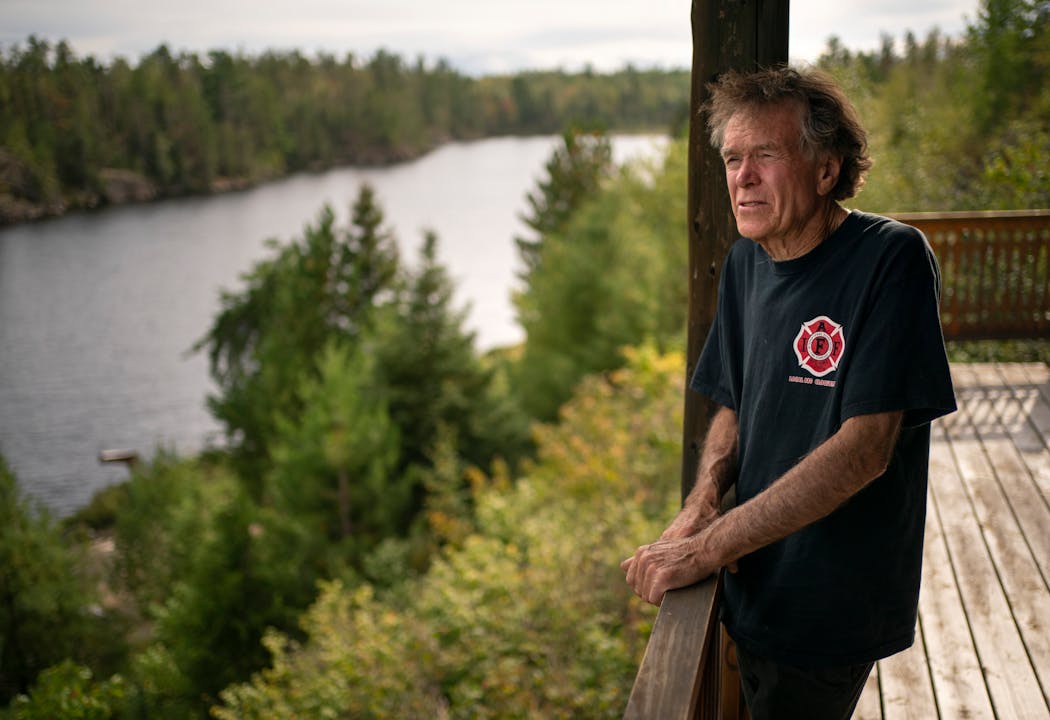Arctic explorer Will Steger saw climate change coming 30 years ago. Ice that throughout human history had been hard as rock was melting, and caribou were forging new migration routes.
To survive, native hunters whose forebears had depended on caribou for food and clothing for 11,000 years hunted farther from their homes or adapted in other ways.
"I remember one Inuit elder telling me he was thankful for the Disney Channel on TV because they could use it to learn the names of the new animals and insects that were moving north with the warmer weather,'' Steger, of Ely, said.
Dallas Hudson has seen changes, too.
A phenologist who lives in the woods near the small northern Minnesota town of Akeley, Hudson studies the recurrence of natural phenomena, such as the springtime return of butterflies. He's also a primitive weapons hunter who this week is in Wyoming attempting to kill an antelope with a bow and arrow he built himself.
"What I see in our area are a lot of weather ups and downs, big variations,'' he said. "And around home we've lost some species that once were abundant, including snowshoe hares and evening grosbeaks.''
Michael Furtman also senses something is up.
A Duluth writer and wildlife photographer whose hunting and fishing cabin on McDougal Lake miraculously survived the 27,000-acre Greenwood inferno that still smolders east of Ely, Furtman says unusual weather is the "new normal.''
"No question things have changed, and not for the better,'' Furtman said. "Years ago, we could time when ducks would migrate through the state. Not anymore. Now it stays so warm in fall that ducks stay in Canada until November, then quickly fly through the state when an early winter storm hits. And I don't even bother hunting pheasants until the end of November. It's too hot before then, and too hard on my dog.''
A tradition that in Minnesota dates to centuries before statehood, hunting still commands the autumn interests of more than a half-million residents. Conducting their exploits outdoors, immersed in nature, hunters throughout history have been among the first to recognize threats to land, water and wildlife, and the first to pick up the tab for their resolution.
They might also be among the first Minnesotans to have their recreation choices, and perhaps their lifestyles, significantly altered by climate change.
Experts say the state's climate already is different than it was a half-century ago, and some of the changes will significantly affect Minnesota fish and wildlife — and hunters and anglers — well into the future.
Perhaps forever.
"For some species, there will be enhanced hunting opportunities, perhaps for deer in particular,'' said Olivia LeDee, acting director of the federal Midwest Climate Adaptation Science Center in St. Paul. "Winter, particularly in northern Minnesota, used to be called the 'grim reaper' for deer. But as winters continue to warm and grow shorter, deer populations will expand.''
Moose, marten and black bears, among other species, and popular Minnesota gamebirds such as ruffed grouse, pheasants and ducks, might not fare as well.
Scientists almost universally agree that human-caused fossil-fuel combustion and deforestation, together with respiration, volcanic eruptions and other natural processes, are the primary causes of climate change.
According to the National Aeronautics and Space Administration (NASA), human activities have raised CO2 in the atmosphere by 48% above pre-industrial levels of 1850. This is more than what occurred naturally in the previous 20,000 years.
Minnesota — and the world — are warming and experiencing more weather extremes as a result.
Adverse effects
Since 1895, average Minnesota temperatures have risen by nearly 3 degrees, and further warming is expected throughout this century. The state's 10 warmest and wettest years on record have occurred in the past 20 years, according to the Department of Natural Resources (DNR), and during the same period, widespread rains of more than 6 inches were four times more frequent than in the previous three decades.
Fish, wildlife and their habitats are threatened by these changes.
"Take ruffed grouse,'' said Greg Hoch, DNR prairie habitat supervisor. "They need snow cover in winter for protection from the weather and from predators. With warming winters and less snow, how will they be affected?''
Indirect effects of climate change might exact even greater tolls.
In warmer winters, for example, winter ticks are more likely to latch onto moose, weakening the big animals and perhaps making them more vulnerable to disease and predators such as wolves.
Moose also are vulnerable to increased mortality if deer numbers increase in northeast Minnesota, because deer benignly carry brain worms, but the parasite is deadly to moose.
Weather destabilization, which can vary significantly by region as the climate changes, also threatens wildlife in the form of downpours and floods. Successful reproduction of virtually all species, birds in particular, depends on temperate, relatively dry weather.
"I think it's important as a conservation community that we recognize the severity of the climate change problem, while working toward solutions,'' said DNR Fish and Wildlife Division director Dave Olfelt.
The DNR, Olfelt said, like other state and federal conservation and environmental agencies, is attempting to mitigate the adverse effects of climate change on fish and wildlife and their habitats, while also adapting to other changes they consider inevitable, including what appears to be an increase of invasive species.
"As an adaptation, can we create and sustain wildlife habitats that are resilient to these changes?'' Olfelt said. "Can we store carbon while we create habitat? The eastern larch beetle is hitting our tamarack forests hard, which affects the health of the bogs and wetlands that support these trees. Spruce budworms also are taking a toll on our forests, as is the emerald ash borer, all of which can lead to catastrophic fires like we've had this summer. These make our forest-management decisions all the more important.''
LeDee, of the Midwest Climate Adaptation Science Center, said her office is charged with delivering science-based options to fish and wildlife professionals and other resource managers.
"When we propose possible interventions to wildlife managers who want to adapt a species or habitat to climate change, we tell them, 'Here's the science and the range of possible outcomes,' '' LeDee said. "It's up to them to decide how much money they want to spend and how much risk they want to take in applying the intervention.''
One option, Hoch of the DNR said, might be to transfer seeds, including those from native plants from Iowa or even farther south, to supplant habitat projects in Minnesota. This could have the broader benefit of sequestering carbon in the ground, which might incentivize society as a whole, not just conservationists, to develop wildlife habitat.
"If the science is correct that the southern part of Minnesota will eventually look more like Iowa or another state farther south, it might make sense to use plants from those areas to produce sustainable habitat,'' Hoch said.
A recent deer opener was so warm, DNR Commissioner Sarah Strommen said, she could have sat in her stand comfortably wearing shorts.
"If that's our future,'' she said, "it will not only change hunting, it will change deer and other wildlife and their habitats. To help offset these changes, we need to better understand the carbon storage potential of the thousands of square miles of lands the DNR manages, including grasslands and forests. We're looking at ways we can track that better.''
Critical to the success of such efforts will be public support. But it remains unclear how much buy-in people have for the kinds of significant, and expensive, lifestyle and other changes needed to stop adding greenhouse gases to the atmosphere.
From 20-year wars in distant lands, to 9/11 remembrances and the ongoing threat of COVID-19 — all of it overarched by divisive politics — multiple generations of Americans have been whiplashed from crisis to crisis.
Asking them to stiffen their backs one more time to fight climate change while also holding down jobs, raising families and paying bills could be a bridge too far.
Steger remains upbeat.
"Hope, yes, what else is there?'' he said. "But we can't sugarcoat what's happening to our climate anymore. It's coming faster than we thought. Now more than ever there are opportunities for leadership.''
Yuen: How success has pushed Minnesotans off sidelines in trans athlete debate
David Festa's return to Twins goes south in a hurry

NBA Finals: Haliburton caps huge rally with winning jumper as Pacers stun Thunder 111-110 in Game 1

Twins call up pitching prospect Travis Adams to bullpen




